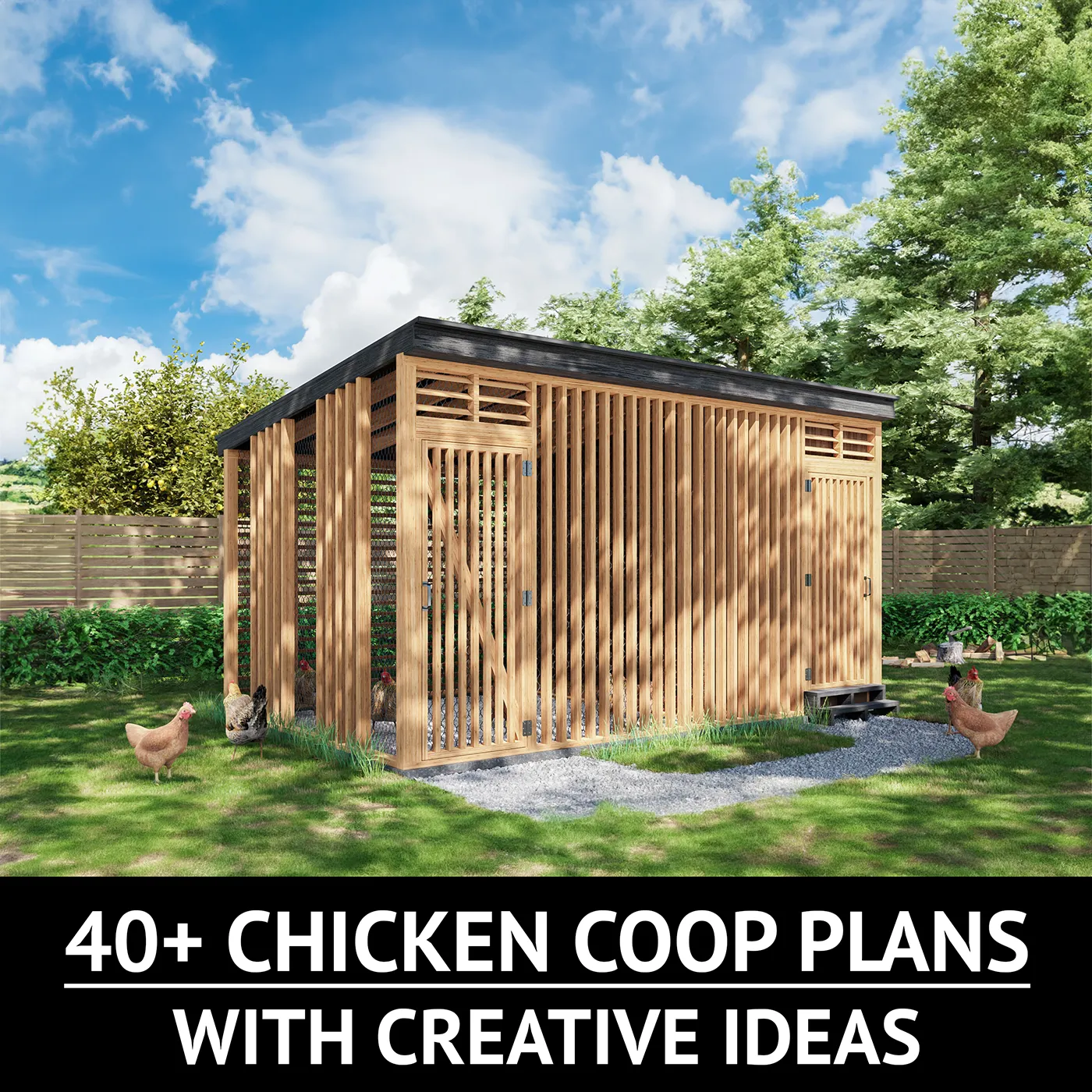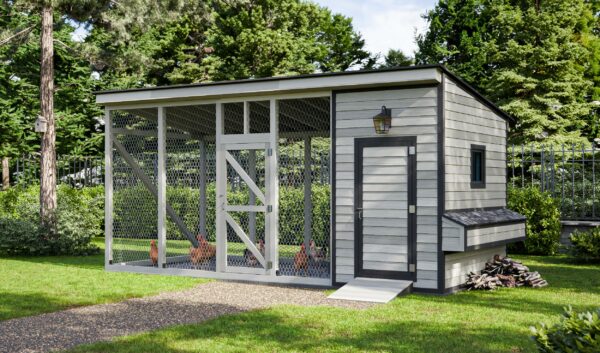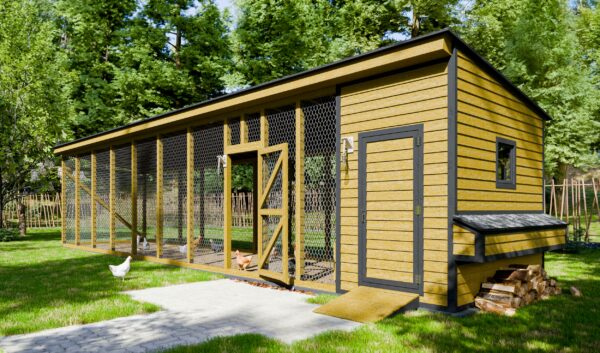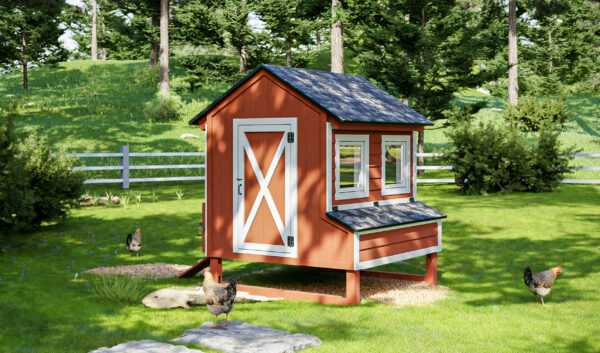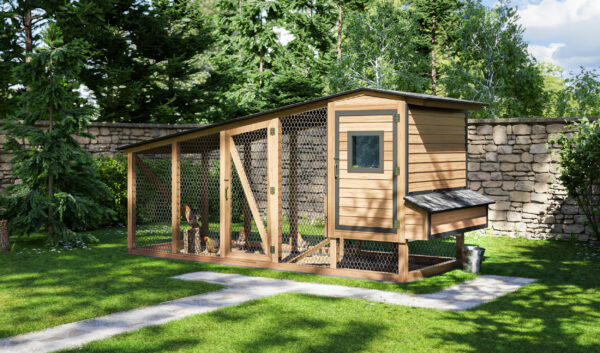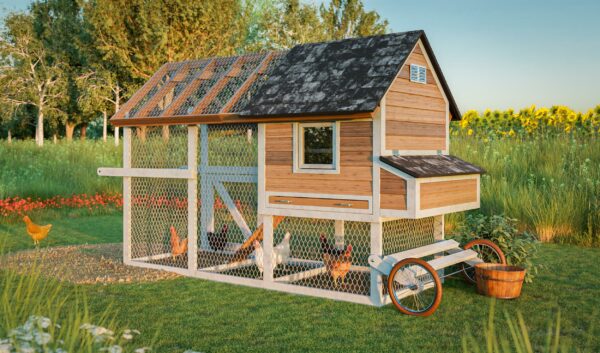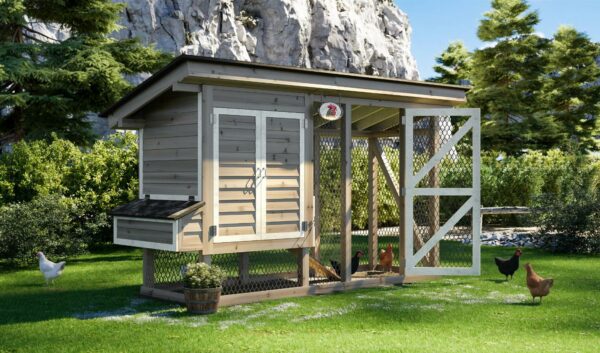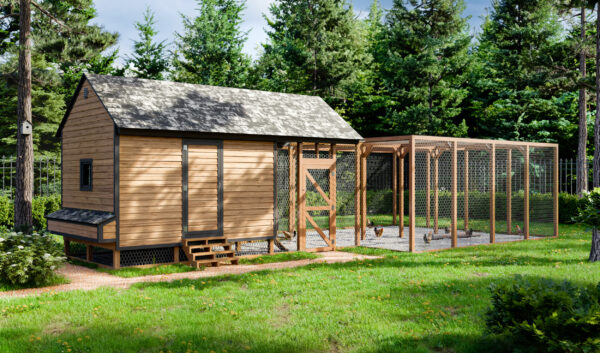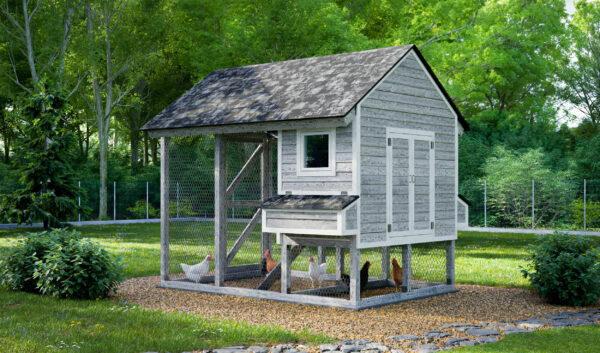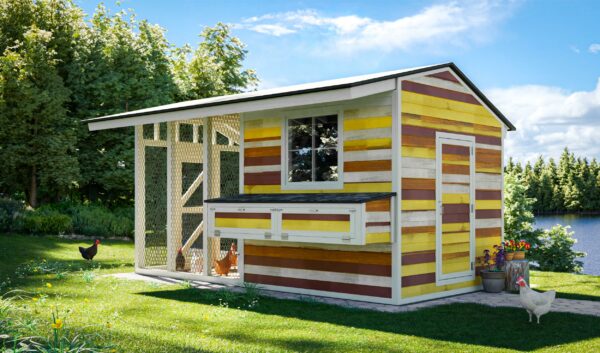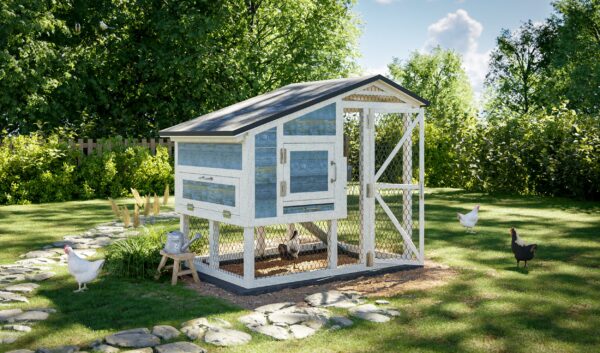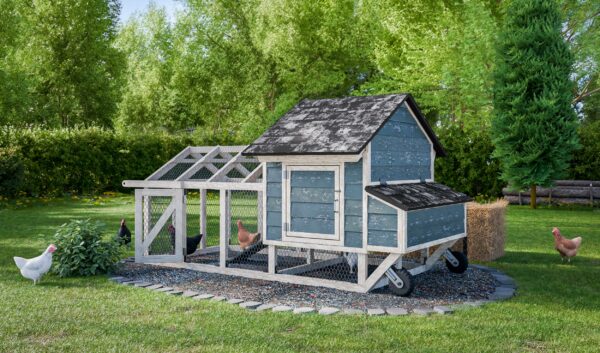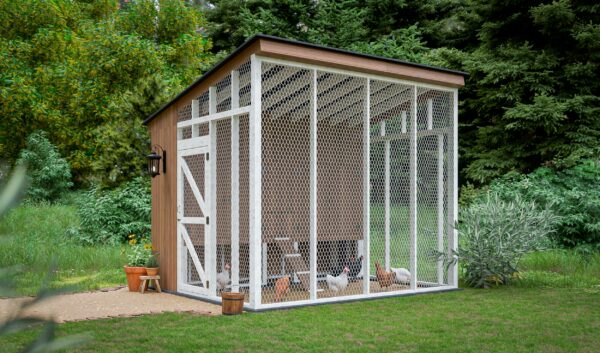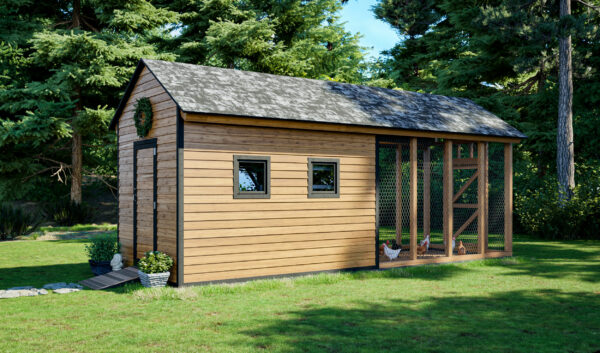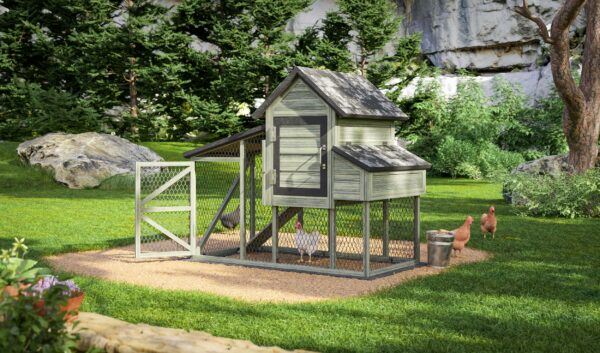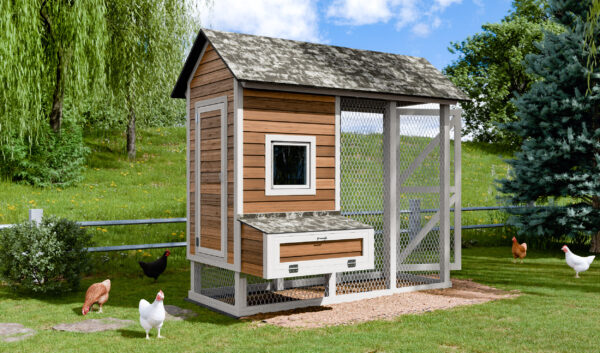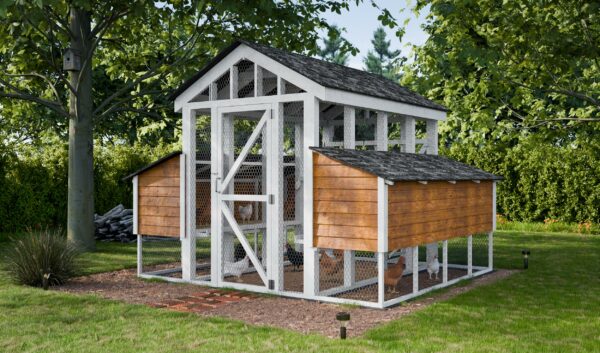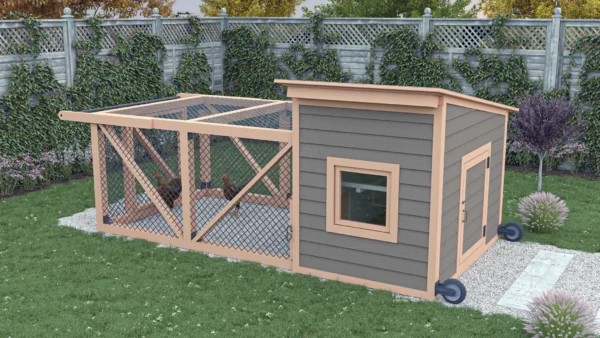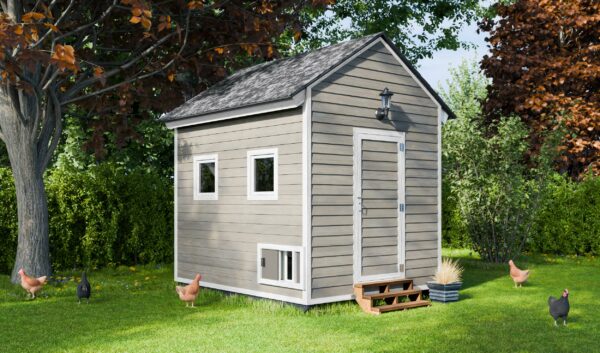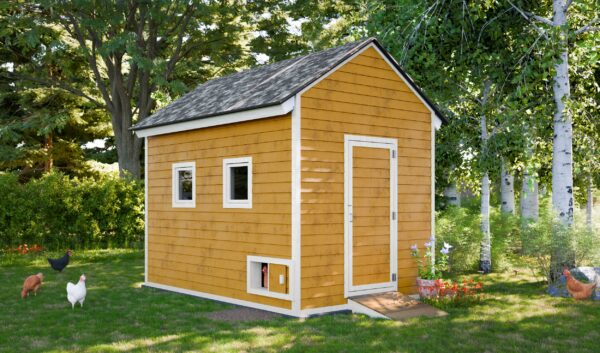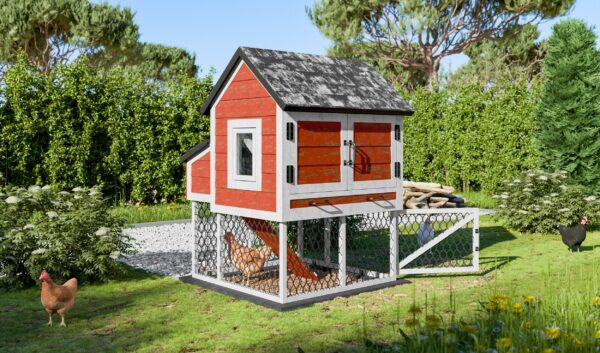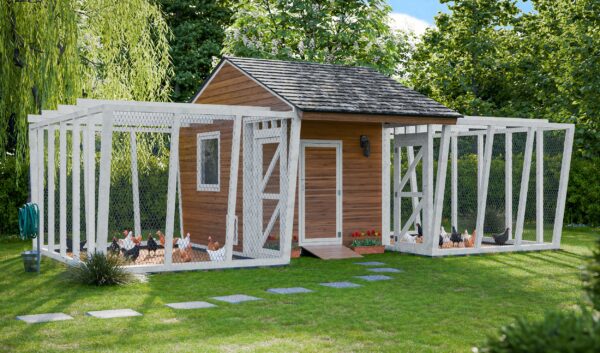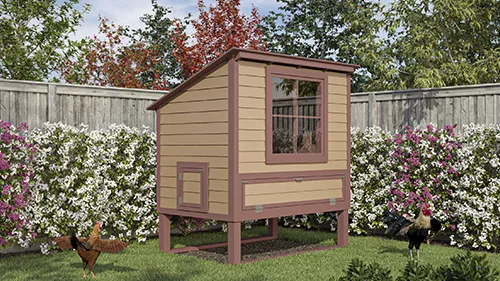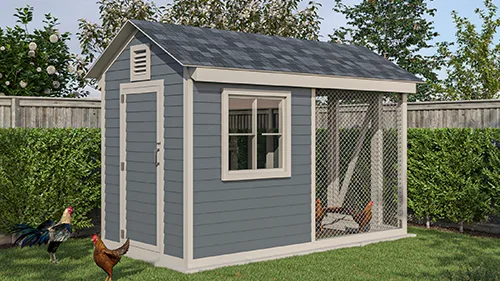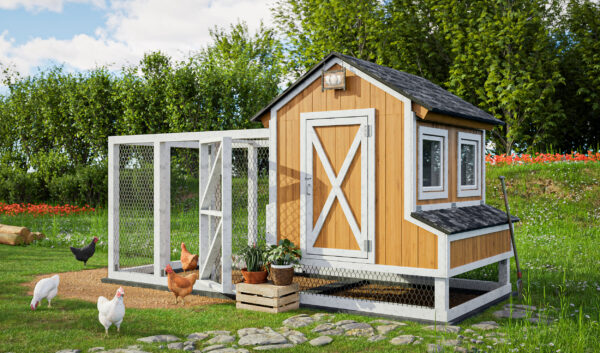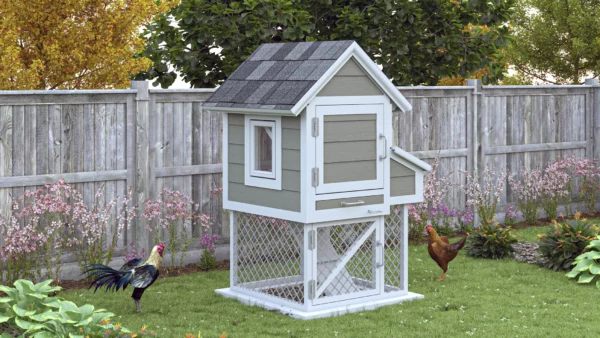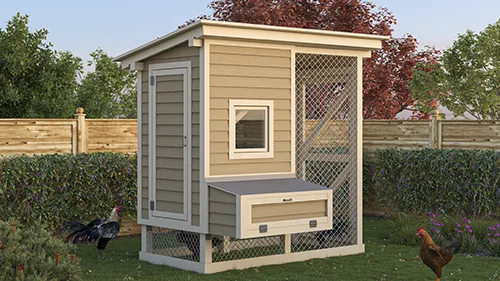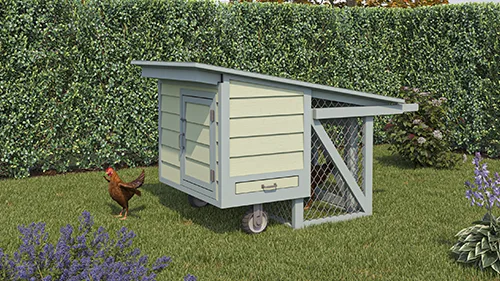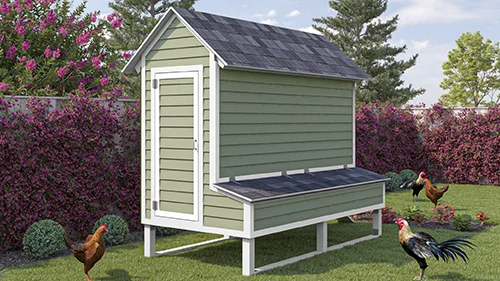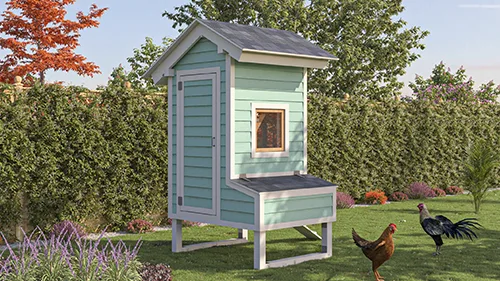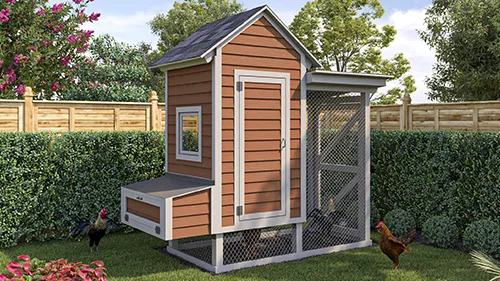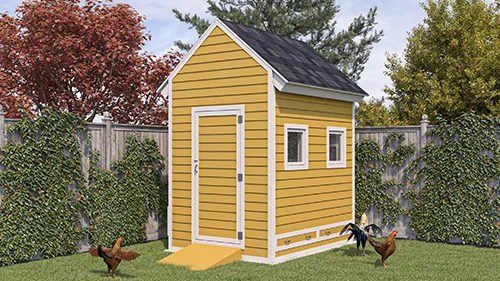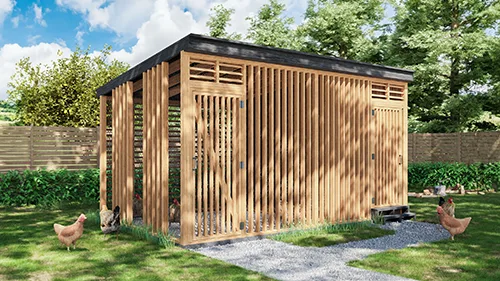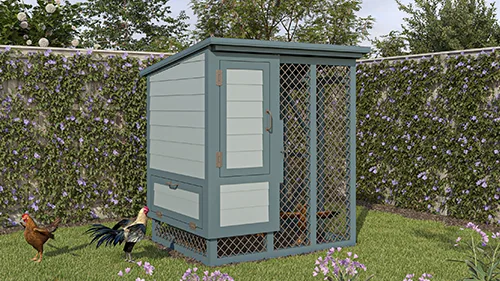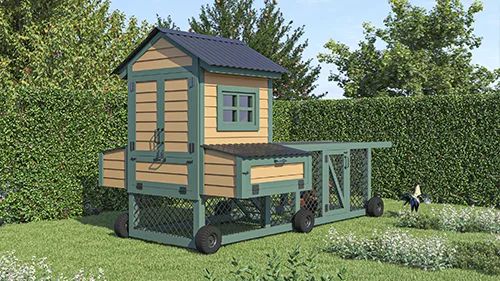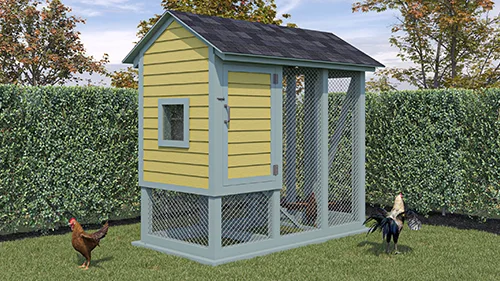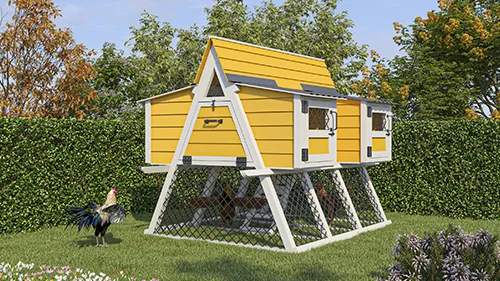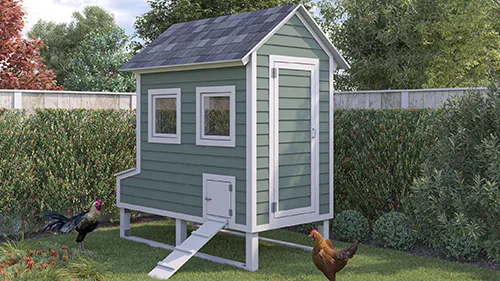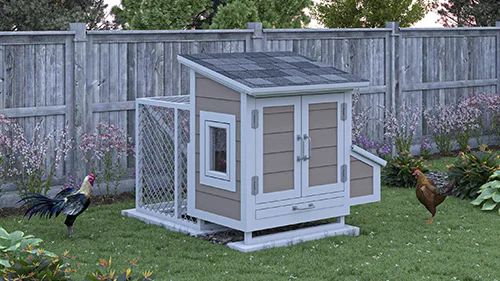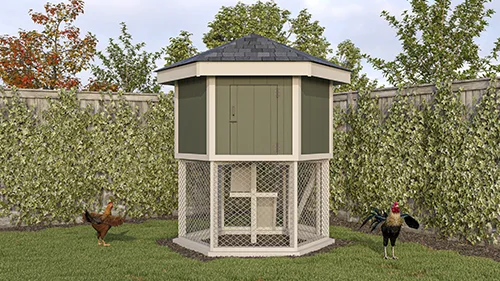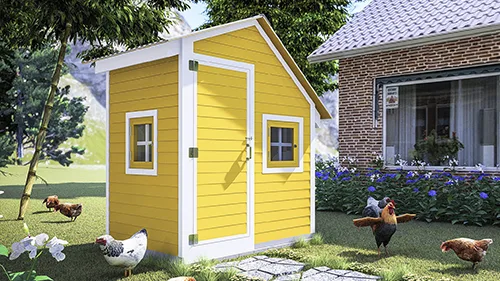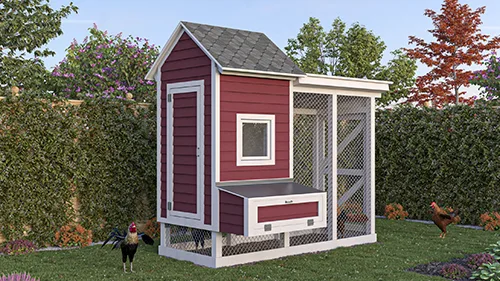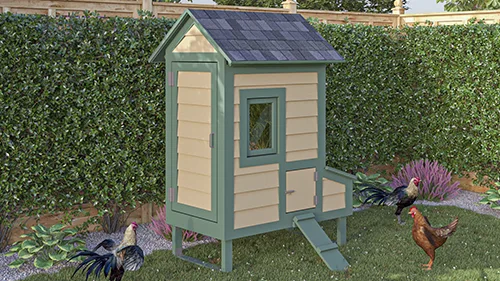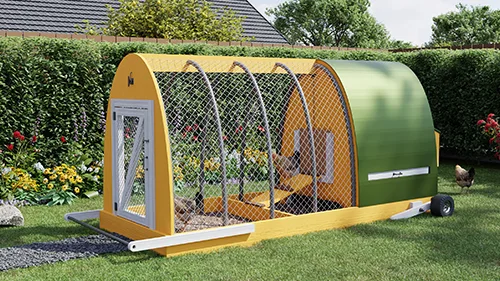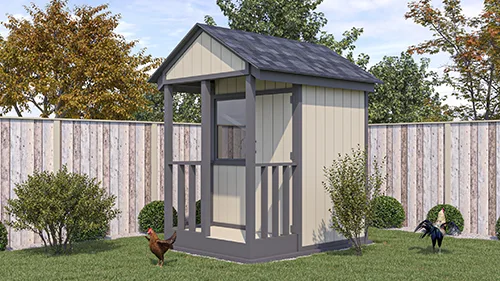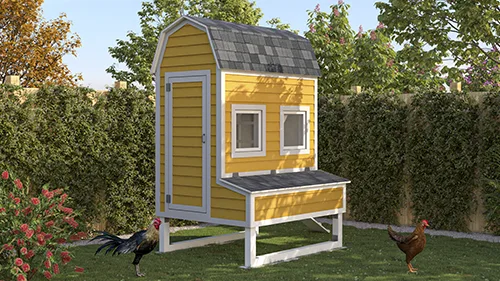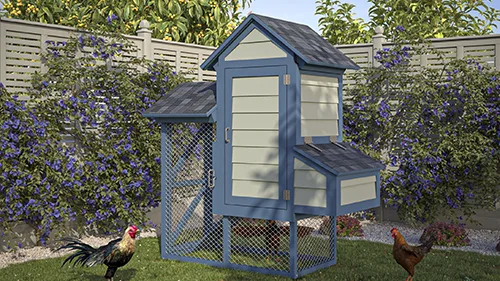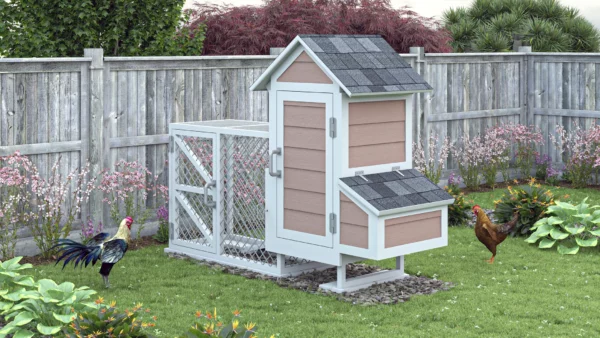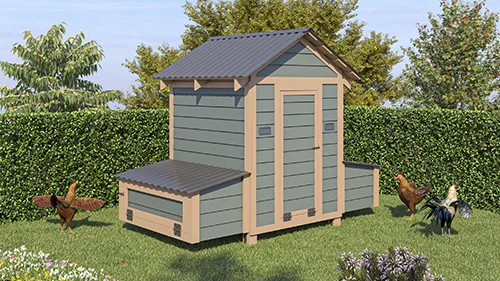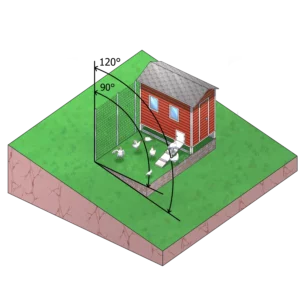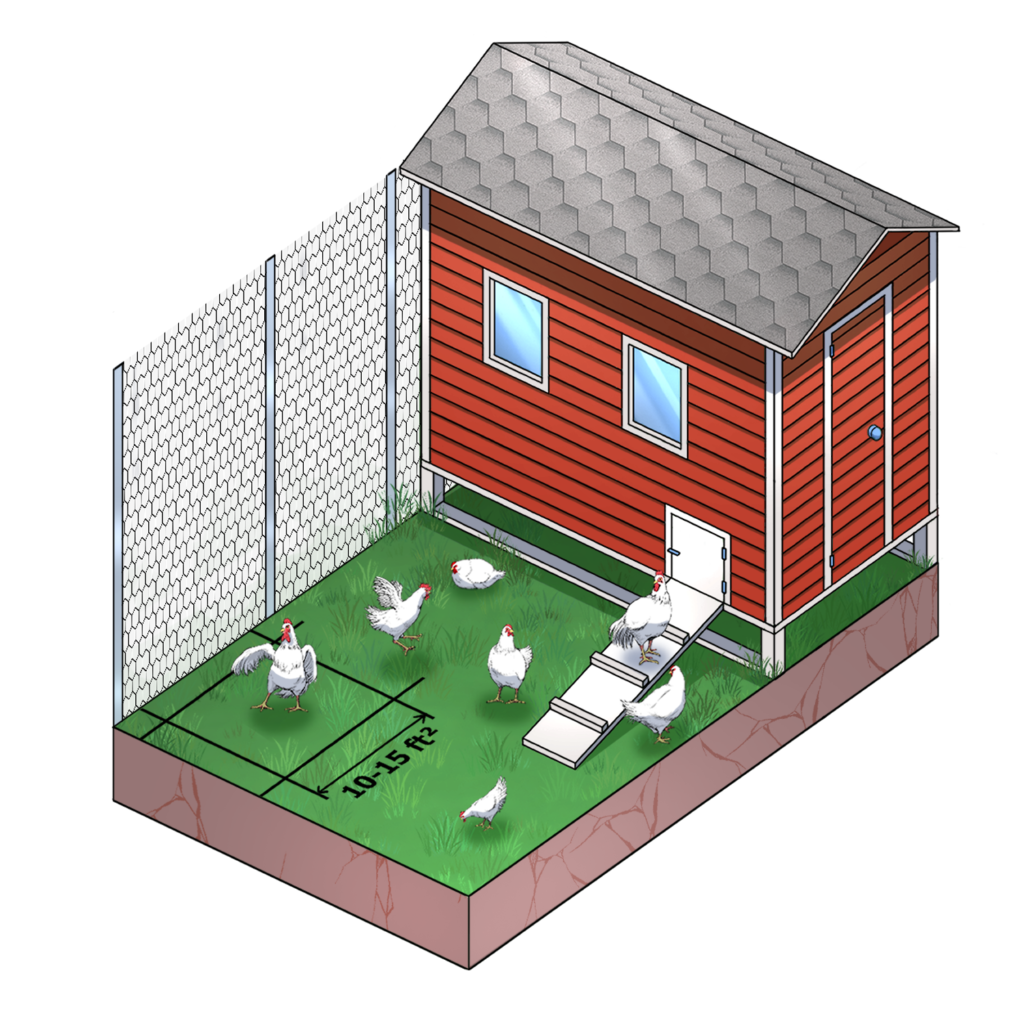DIY Chicken Coop Plans: 40+ Free Beginner Designs!
Our chicken coop plans are specifically designed to simplify the building process while ensuring safety and comfort for your birds. With basic construction skills, you can efficiently build a suitable home for your chickens without excessive time or expense. To assist you, we prepared these user-friendly, budget-conscious plans at no cost.
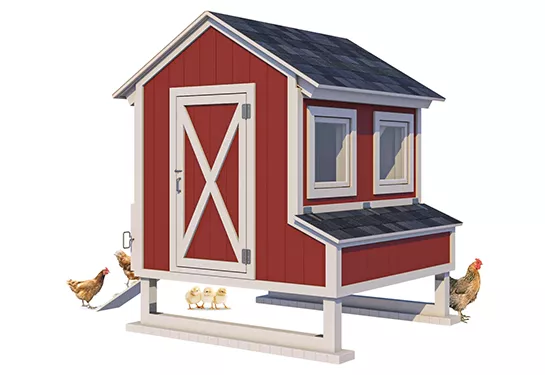
These free chicken coop plans offer sizes from small chicken coops to a large chicken houses. Additionally, they serve as a resource for chicken coop ideas, offering innovative designs and inspiration.
DIY Chicken Coop Plans
-
Walk-In Chicken Coop Plan
This walk-in chicken coop offers a spacious interior to house up to 12 chickens, and the integrated run is a safe space for them to explore and forage during the day. To ensure the safety and health of your flock, it offers a predator-proof design, and you can always get inside to tend to the chickens.
Capacity 12 chickens Dimensions 20 x 9 Difficulty to build Beginner friendly -
Extra large chicken coop with run
The Chicken’s Dream Home plan is designed by a professional architect and offers clear directions to help you construct your Egg-cellent hideaway for your feathered friends. The design allows for plenty of space for the chickens to nest, roost, and run. You can use reclaimed corrugated metal for roofing.
Capacity 20 chickens Dimensions 9 x 42 Difficulty to build Beginner friendly -
Amish-Inspired Chicken Coop
This Amish-style coop suits safe upcountry backyards with nesting boxes accessible from outside, two windows for light, and a droppings tray for easy cleaning. Its design offers a secure living space, raised off the ground, with a main door and a chicken-sized door with a ramp.
Capacity 12 chickens Dimensions 6 x 6 Difficulty to build Medium -
Urban Poultry Palace
This modern loft-design chicken coop is perfect for urban and suburban chicken growers. The elongated run ensures enough space for roaming. Using pallets or scrap wood can keep the costs down. The elevated hutch makes this coop perfect for areas that tend to flood.
Capacity 12 chickens Dimensions 17 x 6 Difficulty to build Intermediate -
Mobile Chicken Coop
Having a portable chicken coop means you can move it whenever and wherever you want to give your chickens fresh grass to scratch and eat. One side of this coop features two sturdy handles that allow you to lift and push it to the desired location in your backyard.
Capacity 8 chickens Dimensions 5 x 13 Difficulty to build Beginner friendly -
Backyard Chicken Coop Plans
This lean-to chicken coop plan is detailed with steps to build a small haven for your chickens. The finished coop offers a healthy and safe space for up to 10 chickens and has a cabinet-style door that offers wide access for hassle-free cleaning and a spacious interior where you can come in and tend to your birds.
Capacity 10 chickens Dimensions 4 x 12 Difficulty to build Intermediate -
Egg-stra Sanctuary for Chickens
Do you have an extensive backyard that you can dedicate to a flock of chickens? This is the best bet. The hutch is inspired by a typical storage shed (storage sheds are known to be sturdy), so it is secure. Adding a spacious run makes it a complete home to raise a large flock.
Capacity 50 chickens Dimensions 40 x 20 Difficulty to build Intermediate -
Country Living’s Chicken Coop
You can use doors from an old cabinet to minimize the overall building costs. The coop is designed to fit in a seemingly small corner of your farmhouse backyard. Functionality and style have been ensured with various components, including the exterior-mounted nesting boxes.
Capacity 12 chickens Dimensions 12 x 8 Difficulty to build Beginner friendly -
Simple Chicken Coop
Designed with efficiency in mind, this chicken coop will hold ten chickens who will have access to a secured aviary, a roosting area, and nesting boxes to hold eggs. Its design incorporates convenient access doors for easy egg harvesting and quick cleanup.
Capacity 10 chickens Dimensions 4 x 6 Difficulty to build Beginner friendly -
DIY Chicken Tractor Plans
Designed with portability in mind, this chicken coop can be easily moved about to offer your flock new grass to scratch and new places to search for worms. The finished coop offers a fenced aviary, roosting area, and nesting boxes for 6.
Capacity 6 chickens Dimensions 4 x 8 Difficulty to build Beginner friendly -
Garage Shed-Inspired Chicken Coop
This spacious retreat resembles a garage shed and features an all-contained coop with integrated large run. If you are planning to raise a large flock, this comprehensive DIY blueprint will guide you through each step of building a coop, including building nesting boxes, installing perches, predator-proofing the run.
Capacity 50 chickens Dimensions 24 x 8 Difficulty to build Intermediate -
Easy Chicken Coop Plans With Run
If all you need is a small flock to produce eggs for household consumption, you can use this chicken coop plan to DIY a haven for your chickens. The blueprint includes instructions to ease the building process. Once built, the coop can hold six chickens and offers enough space for them to explore and forage during the day.
Capacity 6 chickens Dimensions 3 x 6 Difficulty to build Beginner friendly -
Hen’s Paradise
Hen’s Paradise is perfect for those looking for a small unit to try their hands in chicken rearing. The free plan is detailed with a cut list and instructions to help you build a safe haven for your flock. When built, the coop can hold up to 10 chickens. Its gable-style roof and height allow for the installation of more roosting bars.
Capacity 10 chickens Dimensions 4 x 10 Difficulty to build Beginner friendly -
Walk-in Hen House
What’s better than a good-looking chicken coop that one can easily walk into? This is a safe coop that you build for much less. The designer intentionally created the two lofts such that they can only be accessed from inside to enhance security. It has plenty of ventilation to keep the birds cool in summer.
Capacity 10 chickens Dimensions 10 x 12 Difficulty to build Beginner friendly -
Mobile Chicken Coop Plans
This movable hen house will hold ten chickens who will have access to a secured aviary, an indoor area, and nesting boxes. The detailed DIY plan will guide you through every step to ensure you build a safe shelter for your flock.
Capacity 10 chickens Dimensions 6 x 12 Difficulty to build Beginner friendly -
Shed-like Chicken Coop Plans
With an exterior furnished and finished to look like a garden shed, this modernized chicken coop is designed to be predator-proof and has enough nesting boxes plus roosts for 30 chickens. It has a human-sized door equipped with steps for easy access when harvesting eggs and cleaning.
Capacity 30 chickens Dimensions 10 x 8 Difficulty to build Intermediate -
All-Weather Chicken House Plans
This chicken coop can be perfect if you plan on having only a small to medium flock. It offers a predator-proof design, a spacious interior, and sufficient nesting boxes. Moreover, it has a weather proof design, so your chickens are always dry and healthy.
Capacity 20 chickens Dimensions 8 x 12 Difficulty to build Medium -
Small Chicken Coop Plans
Use these garden loft chicken coop plans to build your hens a place where they can call home and cohabit safely. The coop provides a homey environment for six chickens, nesting boxes, and a predator-proof aviary. The cabinet-style doors open to the ample interior to allow you to collect fresh eggs and clean up.
Capacity 6 chickens Dimensions 4 x 4 Difficulty to build Beginner friendly -
All-in-one Chicken Abode
This extra large, all-contained coop is sandwiched between two integrated aviaries and has two chicken-sized doors that open to the aviaries, so you won’t have to let your chickens in and out every time they want to stretch or return inside to lay eggs. With the spacious interior and standard-size access doors, you will have an easy time getting inside the coop to collect eggs and inside the fenced runs to tend to your birds.
Capacity 50 chickens Dimensions 30 x 15 Difficulty to build Advanced -
Tiny Cluckingham Retreat
Do you have a small open corner that you want to make use of? This free chicken coop plan is a complete guide to help you DIY a small yet functional structure that your hens can call home. For its miniature stature, it affords roosting bars and nesting boxes enough for a flock of six. It has a convenience door that makes egg-harvesting straightforward.
Capacity 6 chickens Dimensions 4 x 6 Difficulty to build Beginner friendly -
Walk-In Chicken Coop Plan
This chicken coop is engineered to be sturdy, incredibly protective, and functional. It provides room for ten chickens, a feature-rich aviary, and sufficient nesting boxes to hold eggs. The sturdy framing guarantees longevity and performance.
Capacity 10 chickens Dimensions 6 x 12 Difficulty to build Medium -
Budget-friendly Chicken Coop
This small coop is a true paradise for a small flock. The free plan has all the details you need to build a home for up to 6. With a nine-square-foot footprint, it is suitable for people with a small yard (or budget) who yearn to produce their eggs.
Capacity 6 chickens Dimensions 3 x 3 Difficulty to build Beginner friendly -
Small Flock Chicken Coop Plans
Finding a compact yet all-contained chicken coop can mean having the ultimate solution to raise a decent flock in small backyards. If your goal for raising chickens is to produce eggs for household consumption, these downloadable blueprints can be ideal for you. The coop can hold up to 8 chickens and is lifted to ensure enough space for the bird to explore as they search for worms.
Capacity 8 chickens Dimensions 4 x 8 Difficulty to build Intermediate -
Small Chicken Tractor
If you live in the city and want to enjoy the convenience of having a movable chicken coop, this small chicken coop plan is for you. With a capacity of only four chickens, it is perfectly suited for city life where ordinances restrict the keeping of large flocks.
Capacity 4 chickens Dimensions 3 x 4 Difficulty to build Beginner friendly -
Victorian-Style Chicken Coop
With just 50 square feet of your yard, you can raise a happy flock of up to 12 chickens. This Victorian-style hen house is truly safe, with only two doors(one human-sized and the other chicken-sized) and no windows. Paint the coop with slightly bright tone paints to add interest and function to your backyard.
Capacity 12 chickens Dimensions 5 x 10 Difficulty to build Intermediate -
Space-Saving Chicken House
This free plan is detailed to help you build a fully furnished and quaint home for your feathered friends. It has a large door, windows, and a ramped chicken-sized door for the hens. The space underneath is a cool area where other pets can rest when temperatures get too high.
Capacity 8 chickens Dimensions 5 x 4 Difficulty to build Beginner friendly -
DIY Chicken Coop Plans
House your chickens and give them space to explore safely with this chicken coop. The blueprint is a professionally designed chicken coop plan to simplify coop-building. Once finished, the coop offers a home for ten chickens, space to explore and forage, and sufficient nesting boxes to hold the eggs. The coop area is elevated to provide more space for birds to scratch grass, search for worms, and take refuge from the afternoon sun.
Capacity 10 chickens Dimensions 4 x 8 Difficulty to build Beginner friendly -
Garden Shed Turned Into Hen House
You just built a garden shed and then realize your chicken coop is getting smaller for the flock. Repurposing a new or old garden shed is an easy way to provide your feathered friends with a safe and cozy abode. The height provides plenty of space for installing enough roosting bars and nesting boxes. Proper ventilation also helps ensure proper heat regulation.
Capacity 20 chickens Dimensions 6 x 8 Difficulty to build Beginner friendly -
Modern Walk-in Chicken Run
This luxury looking modern chicken coop, designed to house up to 16 chickens, boasts a spacious run, sturdy construction, and ample roosting bars and nesting boxes. With two large doors for easy access and high-quality security features, it combines rustic charm and practicality.
Capacity 16 chickens Dimensions 10 x 16 Difficulty to build Medium -
Compact Low-Maintenance Chicken Coop
This low-maintenance chicken coop is ideal for practical chicken owners. Although seemingly small, this coop is well-furnished to hold up to 8 chickens. You can use pallets and scrap wood to save on construction costs. A convenience door in the idea allows you to collect eggs without disturbing the birds.
Capacity 8 chickens Dimensions 4 x 5 Difficulty to build Beginner friendly -
Coop on Wheels
Those looking for a truly mobile chicken coop may consider this chicken coop plan. The movable hen house offers room for six chickens, nesting boxes, and an aviary that allows birds to scratch grass and forage for worms. You can quickly move the coop without lifting it; just push.
Capacity 6 chickens Dimensions 8 x 15 Difficulty to build Intermediate -
Urban Chicken Coop
Are you living in a condo and want to produce eggs for household consumption? This hen house is only 4 feet wide, making it ideal for raising chickens in an urban setting. It can hold up to 8 birds. The run extends underneath the hutch to provide plenty of roaming space.
Capacity 8 chickens Dimensions 4 x 8 Difficulty to build Beginner friendly -
A-Frame Chicken Coop
Many people love A-frame chicken coops because they are budget-friendly, easy to build, and movable. These printable free A-frame chicken coop plans are professionally designed to help even amateur woodworkers build the intricate tall-standing coop. Once built, the coop will provide a home to 6 chickens, a fenced aviary, and nesting boxes to hold the eggs. The design allows you to collect eggs and clean up the coop from outside.
Capacity 6 chickens Dimensions 7 x 6 Difficulty to build Beginner friendly -
Elevated Hen House
Ideal for beginners looking for chicken coop plans for eight chickens, this blueprint makes it easy for you to build your hens a place they can call home. The coop is elevated to minimize threats posed by predators and floods. Moreover, the design incorporates two doors (human-sized and chicken-sized), windows, and a protruding nesting box, which ensure good looks once built.
Capacity 8 chickens Dimensions 4 x 8 Difficulty to build Intermediate -
Small And Accoutred Hen House
This is a tiny sanctuary for keeping a tiny flock. But don’t let the 15 square feet footprint fool you. When built, this coop can accommodate up to 6 chickens. Its intricate design ensures both functionality and style. Here, the coop is placed in a spot that receives plenty of light to ensure optimal egg production.
Capacity 6 chickens Dimensions 3 x 5 Difficulty to build Beginner friendly -
Multi-level DIY chicken coop Plan
This multi-level chicken coop plan has been designed by a professional to help chicken lovers of all levels create a haven that will not only house their hens but also add interest to their property. Even with its hexagonal shape, the coop is furnished with everything you need to raise a safe, happy, and healthy clock of ten chickens.
Capacity 10 chickens Dimensions 7 x 8 Difficulty to build Medium -
Backyard Shed Coop
If you already have a garden shed on your property, this comprehensive plan is designed to help you build a chicken coop that will complement your shed. When complete, the coop offers a safe abode for your chickens with enough nesting boxes, roosts, and ample ventilation.
Capacity 10 chickens Dimensions 5 x 6 Difficulty to build Intermediate -
Cluckingham Palace
This free plan is a detailed guide to help beginner chicken growers build a sturdy home for their birds. The complete hen house has all the necessary amenities to raise ten birds. There is a large door, a window, and an exterior nesting box that allows you to collect eggs from outside.
Capacity 10 chickens Dimensions 4 x 10 Difficulty to build Intermediate -
Cozy Cottage
This chicken coop is designed to resemble a miniature barn. Its height provides more space for installing roosting bars. It is also designed with convenience in mind. The ramped chicken-size door allows chickens to easily enter and leave the coop and is strategically placed near the nesting boxes.
Capacity 6 chickens Dimensions 2 x 4 Difficulty to build Beginner friendly -
Greenhouse Chicken Coop Plan
Use this chicken coop plan to DIY a shelter that resembles a greenhouse in shape. This arc-style streamlined design is suitable for rural neighborhoods and offers ample ventilation for proper air circulation, which makes it suitable for poultry farmers in hot regions. One side of the coop is equipped with wheels to allow you to move it to give your flock new grass to scratch and eat.
Capacity 8 chickens Dimensions 4 x 12 Difficulty to build Beginner friendly -
Cottage Style Chicken Coop Plans
This chicken coop is disguised as a playhouse, but its interior is furnished with nesting boxes, roosts, and other essentials you need for a flock of up to 12 chickens. Its sturdy design keeps predators and other threats away. Best of all, your woodworking skill level doesn’t matter; the plans will help you get started with your project in no time.
Capacity 12 chickens Dimensions 6 x 8 Difficulty to build Medium -
Charming Dutch-Style Chicken Barn
This roost and nest-only chicken barn provides a safe and healthy haven for a flock of up to 10 birds. Its Dutch-style design incorporates a large access door, windows, and protruding nesting box, allowing for outside egg harvesting. The coop is perfectly suitable for rural and suburban settings.
Capacity 10 chickens Dimensions 5 x 6 Difficulty to build Intermediate -
A Compact Hen’s Hut
This is a small coop that you can construct using pallets. The free plan is detailed to help you give your chickens a nice, safe home where they can flourish. To ensure functionality, it has a door that allows you to collect eggs from outside.
Capacity 6 chickens Dimensions 3 x 4 Difficulty to build Beginner friendly -
All-in-One City-Worth Chicken Coop Plans
For those in urban areas where you can only have a small flock, consider this plan to build a compact all-contained chicken coop. Once built, the coop can hold six chickens who will have access to a predator-proof aviary, a roosting area, and nesting boxes. The design allows for egg harvesting from outside, and the large access doors make cleanup easy.
Capacity 6 chickens Dimensions 2 x 4 Difficulty to build Beginner friendly -
City-Worthy Extra-Small Hen House
It is possible to keep a small flock without taking up a lot of space. This extra small coop is perfect for people living in busy towns with restrictions on raising chickens. You only need 12 feet of floor space. The attached enclosed run gives your chickens a safe space outdoors.
Capacity 6 chickens Dimensions 2 x 6 Difficulty to build Beginner friendly -
Cottage Style DIY Chicken Coop Plan
Are you looking for a rewarding weekend project? Building a chicken coop is a cheaper way to provide your flock with a place they call home. This coop is designed with convenience in mind. The door doubles as a ramp, which makes it effortless for your chickens to enter and exit. Convenience doors are also included in the nesting boxes to allow for egg collection from outside.
Capacity 6 chickens Dimensions 4 x 4 Difficulty to build Intermediate
Our Chicken Coop Plans Benefits
✓ Simplified process
Our plans take the complexity out of building a chicken coop, offering clear instructions and a materials list, ensuring a successful project, and saving you time and frustration.
✓ Save time and money
Our plans have all the required materials, making it easier to shop and save money. Additionally, following our plans can save you the time you would otherwise spend designing and constructing a chicken coop from scratch.
✓ Overcome zoning and location restrictions
By using our chicken coop plans, you can comply with local zoning ordinances and restrictions, making it easier to start your hobby of raising chickens without worrying about breaking any laws.
✓ Gain knowledge and expertise
Our chicken coop plans are designed to help anyone, regardless of their carpentry or construction experience, build a chicken coop with ease, making it possible for everyone to enjoy the benefits of raising chickens.
Selecting the Best Chicken Coop Design
Chicken coops provide a happy and healthy place for your flock to call home. Whether you are an aspiring chicken grower or an old pro, knowing the different types of chicken coops is crucial to the chicken-rearing hobby. This is vitally important because different coops are designed to hold different capacities.
Always remember it is important to build and maintain a chicken coop that is not seen as a nuisance or eye sore by neighbors. Most complaints about chickens being raised in developed areas are due to poorly designed or maintained coops that distract from the appearance of the neighborhood. The public always sees the worst-looking chicken coops and runs as an example of what to expect from everyone, which leads to more restrictions.
For the unacquainted, there are limitless ideas and coop designs — a chicken coop can be any shape or configuration imaginable. While you can easily find unusually elaborate chicken coops, most hen houses fall under the following types:
1. A-Frame Chicken Coop
Also known as Chicken Ark, an A-frame chicken coop is a small rectangular unit that keeps chickens confined. As the name suggests, it has two sharply sloping walls that meet off the ground, so the coop resembles the letter A. Despite being small, A-frame chicken coops have a nesting box or two, a roosting bar, and space for your chickens to move around. They are popular among beginner chicken growers and in cities where ordinances restrict chicken roaming.

A typical chicken ark is usually designed to host two to four chickens but can be designed with a larger capacity.
2. Chicken Tractor
A chicken tractor is a coop on wheels. The inspiration behind the design is the high level of functionality and movement they offer.

A chicken tractor can include a run or not, but the entire structure is usually lightweight for hassle-free moving. Because they are designed to be moved around, chicken tractors are also relatively compact. Grab bars, or wheelbarrow-like handles, are usually included on one end so you can lift and move the coop wherever and whenever needed.
The biggest issue with this design is the need to manage the movement of the coop. It is critical to move the coop often so you do not allow the area under the coop to become eaten down to damage the vegetation. Also, if you have a small lot, you can quickly develop a yard with patches of bare spots throughout the yard.
3. Walk-in Chicken Coop
As the name suggests, walk-in chicken coops are hen houses designed with a large access door so that you can walk in. This type of coop can be the chicken’s home, or they can provide a small door for the chickens to access the outdoors. It can be built from scratch or repurposed as a backyard storage shed. The most exciting thing about walk-in chicken coops is that they are usually permanent structures, and you can go as big as you want.

Because there’s more room inside, they are easier to clean. This style also allows you to add nesting boxes, roosting bars, enrichment, and accessories to create a more inviting environment for your flock. Many owners also build in a small storage area for storage of feed, equipment, and other supplies needed to clean or care for the birds.
No matter the size, an excellent all-in-one chicken coop should be easy to clean and save time.
4. All-in-one Chicken Coop
All-in-one chicken coops are elaborate and substantial hen houses with a walk-in coop (complete with enough nesting boxes and roosting bars) and a sizeable free range. They come in a wide range of sizes and shapes, so there is something for every flock.

No matter the size, an excellent all-in-one chicken coop should be easy to clean and save all time.
